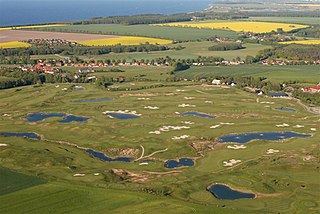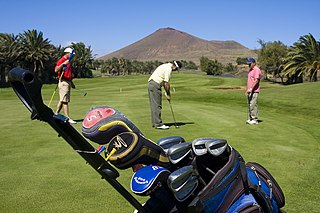A pitching wedge is a wedge used to hit a shot with higher and shorter trajectory than a 9-iron and a lower and longer trajectory than a gap wedge.
A pitching wedge is a wedge used to hit a shot with higher and shorter trajectory than a 9-iron and a lower and longer trajectory than a gap wedge.
Though technically a wedge, pitching wedges are generally treated as if they were numbered irons. This is for a number of reasons: first, before the term "wedge" became common for high-loft short irons, the pitching wedge was actually numbered as the "10-iron" of a matched set, and to this day it follows the normal loft progression of the numbered irons. Also, even though it has been named a wedge, many matched iron sets for retail sale include the pitching wedge even when not including other wedges. Finally, the loft of modern irons has been reduced compared to older designs. This is both to compensate for cavity-back iron designs that launch the ball higher for a given loft, and to increase the distance carried by each club for the average golfer's clubhead speed. (Professionals now also use similar designs, preserving the gap in hitting distance between the amateur golfer and the pro.) As a result the loft of the pitching wedge decreased along with the numbered irons from a traditional loft of between 48–54° to between 45–50°, similar to that of an older 8-iron. Many pitching wedges have a loft close to 50°.
The pitching wedge is a very versatile club. Being on the cusp between numbered irons and wedges, the pitching wedge has generally accepted uses falling into either class. Used with a "full swing" similar to a short iron, a golfer can produce a high-trajectory shot that carries between 80–130 yards (73–119 m) (depending on a variety of factors such as swing and club design), then "bites" with little or no roll after initial impact. Used with an abbreviated "chipping" motion, the club can produce short (25–45 yd (23–41 m)) "lob" or "approach" shots. And with a "putting" motion, the club can lift the ball over rough or fringe onto the putting green from a short distance to the pin (10–25 yd (9.1–22.9 m)). This last kind of stroke is commonly called a "bump and run" and can be done with many other irons, generally with a loft equal or higher than a 7-iron.
These clubs are most commonly used with a full swing to produce high-altitude shots such as approaches to the green or lifting the ball over trees. They are also commonly used to "lay up" in front of a hazard or to create a better lie for the next shot, and for recovery from firmer rough or sometimes from sand when the ball is lying on top of the surface. The loft of a particular pitching wedge follows the progression of the numbered irons of the same set, and these sets can have subtle differences in the loft progression and starting loft of the set, so the loft of pitching wedges can vary widely between sets. The loft of a pitching wedge generally falls between 42 and 49 degrees, but the launch angle and the average carry distance of the club between sets are typically similar. Pitching wedges can also have between zero and 10 degrees of bounce, though most pitching wedges have very low bounce (only 2 or 3 degrees) as other wedges like gap wedges or sand wedges are more traditionally suited for play out of hazards or soft lies where high bounce is desired.

A sand wedge, or sand iron, is a type of golf club, an open-faced wedge primarily designed for getting out of sand bunkers. It has the widest sole of any wedge, which provides the greatest amount of bounce, allowing the club head to glide through sand and avoid digging in. After Gene Sarazen had success in 1932 with a new club that he had invented for sand play, its popularity quickly grew. The club can be advantageous in other soft lies—such as thick rough, soggy ground, or mud—and is also used from firmer grass lies for lobs or chips.

A golf course is the grounds on which the sport of golf is played. It consists of a series of holes, each consisting of a tee box, a fairway, the rough and other hazards, and a green with a cylindrical hole in the ground, known as a "cup". The cup holds a flagstick, known as a "pin". A standard round of golf consists of 18 holes, and as such most courses contain 18 distinct holes; however, there are many 9-hole courses and some that have holes with shared fairways or greens. There are also courses with a non-standard number of holes, such as 12 or 14.

This is a general glossary of the terminology used in the sport of cricket. Where words in a sentence are also defined elsewhere in this article, they appear in italics. Certain aspects of cricket terminology are explained in more detail in cricket statistics and the naming of fielding positions is explained at fielding (cricket).
A golf club is a club used to hit a golf ball in a game of golf. Each club is composed of a shaft with a grip and a club head. Woods are mainly used for long-distance fairway or tee shots; irons, the most versatile class, are used for a variety of shots; hybrids that combine design elements of woods and irons are becoming increasingly popular; putters are used mainly on the green to roll the ball into the hole. A set of clubs is limited by the rules of golf to a maximum of 14 golf clubs, and while there are traditional combinations sold at retail as matched sets, players are free to use any combination of legal clubs.

A golf ball is a special ball designed to be used in the game of golf.
The following is a glossary of the terminology currently used in the sport of golf. Where words in a sentence are also defined elsewhere in this article, they appear in italics. Old names for clubs can be found at Obsolete golf clubs.

In the sport of golf, a wedge is a subset of the iron family of golf clubs designed for special use situations. As a class, wedges have the highest lofts, the shortest shafts, and the heaviest clubheads of the irons. These features generally aid the player in making accurate short-distance "lob" shots, to get the ball onto the green or out of a hazard or other tricky spot. In addition, wedges are designed with modified soles that aid the player in moving the clubhead through soft lies, such as sand, mud, and thick grass, to extract a ball that is embedded or even buried. Wedges come in a variety of configurations, and are generally grouped into four categories: pitching wedges, sand wedges, gap/approach wedges and lob wedges.
In golf, a gap wedge, also known as an approach wedge, is a wedge used to hit a shot with higher and shorter trajectory than a pitching wedge and lower and longer trajectory than a sand wedge. The name derives from the club's design to fill the "gap" between sand and pitching wedges.
The shaft of a golf club is the long, tapered tube which connects the golfer's hands to the club head. While hundreds of different designs exist, the primary purpose of the golf shaft remains the same: to provide the player with a way to generate centrifugal force in order to effectively strike the ball. When properly gripped the player can hit the ball further and more accurately, whilst applying less force.

Golf equipment encompasses the various items that are used to play the sport of golf. Types of equipment include the golf ball, golf clubs, and devices that aid in the sport.
Early golf clubs were all made of wood. They were hand-crafted, often by the players themselves, and had no standard shape or form. As the sport of golf developed, a standard set of clubs began to take shape, with different clubs being fashioned to perform different tasks and hit various types of shot. Later, as more malleable iron became widely used for shorter-range clubs, an even wider variety of clubs became available.

A wood is a type of club used in the sport of golf. Woods have longer shafts and larger, rounder heads than other club types, and are used to hit the ball longer distances than other types.

An iron is a type of club used in the sport of golf to propel the ball towards the hole. Irons typically have shorter shafts and smaller clubheads than woods, the head is made of solid iron or steel, and the head's primary feature is a large, flat, angled face, usually scored with grooves. Irons are used in a wide variety of situations, typically from the teeing ground on shorter holes, from the fairway or rough as the player approaches the green, and to extract the ball from hazards, such as bunkers or even shallow water hazards.

A hybrid is a type of club used in the sport of golf with a design borrowing from both irons and woods while differing from both. The name "hybrid" comes from genetics to denote a mixture of two different species with desirable characteristics of both, and the term here has been generalized, combining the familiar swing mechanics of an iron with the more forgiving nature and better distance of a wood.

A putter is a club used in the sport of golf to make relatively short and low-speed strokes with the intention of rolling the ball into the hole from a short distance away. It is differentiated from the other clubs by a clubhead with a very flat, low-profile, low-loft striking face, and by other features which are only allowed on putters, such as bent shafts, non-circular grips, and positional guides.

Golf is a club-and-ball sport in which players use various clubs to hit a ball into a series of holes on a course in as few strokes as possible.

The golf swing is the action by which players hit the ball in the sport of golf. The golf swing is a complex motion involving the whole body; the technicalities of the swing are known as golf stroke mechanics.
A lob wedge, also known as a lofted wedge or an L-Wedge, is a wedge used in the sport of golf, known for being one of the shortest-hitting clubs and providing the most loft on a shot. Lob wedges are used to produce shots with a very high arc, and are most often used for shots over hazards and other obstructions. Due to the high arc of the shot the lob wedge, like the other wedges in the set of irons, produces little roll after landing on the putting green and can even be used to produce backspin if necessary. Lob wedges are one of the newest additions to the modern collection of golf clubs and, along with the sand wedge and gap wedge, were not included prior to 1931.

Indoor golf is an umbrella term for all activities in golf which can be carried out indoors. Venues include indoor driving ranges, chipping areas, putting greens, machines and home golf simulators. Many of these indoor facilities are businesses that include additional entertainment options as well as food and drink for customers.

PangYa was an online multiplayer casual golf simulation game designed by Korean development company Ntreev Soft and NCSoft.